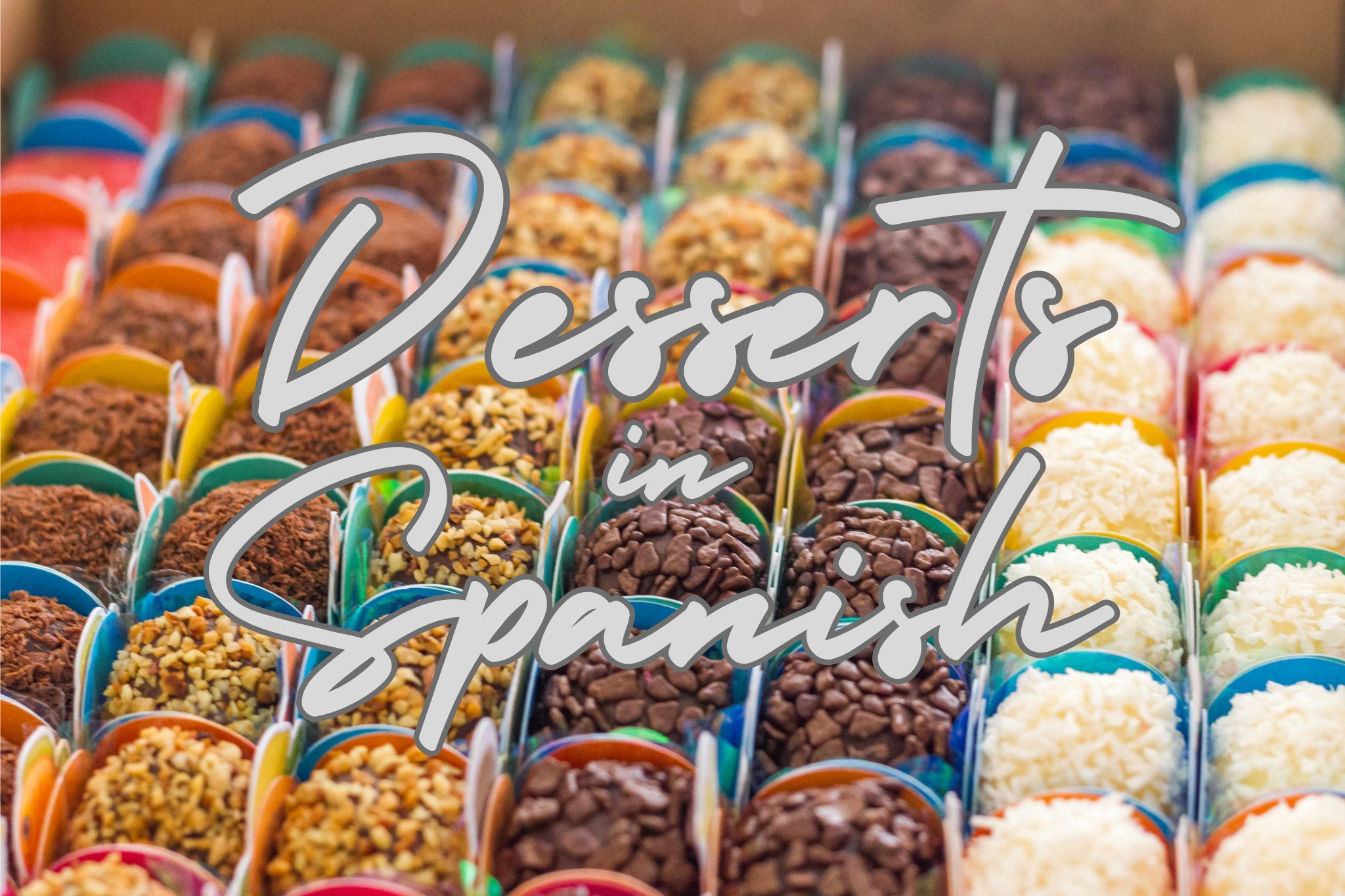Desserts in Spanish: A Sweet taste of Latin American desserts

Get our free email course, Shortcut to Conversational.
Have conversations faster, understand people when they speak fast, and other tested tips to learn faster.
More infoFood is a big part of the culture across Latin America, so it’s always useful to know the names of the local cuisines. In our other posts we‘ve already introduced Spanish food vocab, popular Hispanic dishes, and even regional table etiquette, so today we’ll focus on desserts in Spanish.
The locals take these things very seriously, so we’ll start off by looking at the important differences between a sweet in Spanish and a dessert in Spanish. We’ll see the general words for each type, and then we’ll dive into our vocab lists for both sweets and desserts.
Finally, we’ll satisfy our sweet tooth by describing many of the popular desserts in Spanish-speaking countries. When you’re ready to take a bite, we’ll round out the lesson with a list of useful verbs you’ll need to enjoy your desserts in Spanish.
So grab a spoon, and get ready for a mouthwatering Spanish dessert adventure!!
How to say Dessert in Spanish
First thing’s first: how do you say dessert in Spanish? Before answering this question, let’s see the differences between sweet and dessert in Spanish.
A sweet generally refers to any food that has a high sugar content and a sweet taste. This includes candies, chocolates, and sugary foods. Sweet is both an adjective and a noun in both languages.
A dessert is always a noun, which refers to something sweet that’s a bit more complex and can be considered a dish on its own. Desserts follow recipes and require more elaborate preparation, and include dishes like cakes, pies, and puddings.
Desserts are frequently served as the final course of a meal, whereas sweets are often enjoyed anytime as little indulgences.
Spanish word for dessert is un postre, while the word for sweet in Spanish is un dulce for the noun and dulce for the adjective. In many cases, un dulce can also be considered as un postre because of its preparation.
Sweets in Spanish: Vocabulary
Now, it’s time to take our first bite into los dulces. Here is some vocabulary covering many of the standard sweets in Spanish.
| Sweets | Dulces |
| Chocolate | El chocolate |
| Ice cream | El helado |
| Cookie | La galleta |
| Chewing gum | El chicle |
| Marshmallow | El malvavisco |
| Cotton candy | El algodón de azúcar |
| Candy | El caramelo |
| Caramel | El caramelo |
- The grandmother always had candy in her purse for her grandchildren. – La abuela siempre tenía caramelos en su bolso para los niños.
- I love caramel in desserts, especially in caramel flan. – Me encanta el caramelo en los postres en especial en el flan de caramelo.
You may have noticed that caramelo in Spanish can mean both caramel and candy. It’s all about context. In our first example sentence it refers to candy in general, while in the second one, caramelo refers to the sweet, amber-colored syrup used for desserts. The syrup can’t appear in plural, so whenever you hear los caramelos in Spanish you can be sure they’re candies.
In other words, los caramelos and los dulces are both good options for talking about candies in general!
Desserts in Spanish: Vocabulary
Now let’s see the essential vocab for common postres in Spanish.
| Desserts | Postres |
| Cake | Una torta |
| Birthday cake | Una torta de cumpleaños |
| Brownie | Un brownie |
| Cupcake | Un ponqué |
| Pudding | Un pudín |
| Pastry | Un pastel |
| Donut | Una dona |
| Flan | Un flan |
- She wants a chocolate cake. – Ella quiere una torta de chocolate.
- My aunt bought a cotton candy and a strawberry cupcake. – Mi tía compró un algodón de azúcar y un ponqué de fresa.
Descriptions of Desserts in Spanish
Let’s expand our vocabulary with common adjectives that we use to describe desserts in Spanish. Several of these are invariable adjectives, meaning that they don’t have different masculine and feminine forms.
| English dessert adjectives | Spanish dessert adjectives |
| Tropical | Tropical |
| Sugary | Azucarado/a |
| Sweet | Dulce |
| Creamy | Cremoso/a |
| Rich | Rico/a |
| Powdery, Powdered | En polvo |
| Savory | Sabroso/a |
| Smooth | Suave |
| Firm | Firme |
| Delicious | Delicioso/a |
| Silky | Sedoso/a |
| Buttery | Mantecoso/a |
| Glazed | Glaseado/a |
| Gooey | Pegajoso/a |
- The donuts at the bakery were glazed in a sweet sauce. – Las donas de la panadería estaban glaseadas en una salsa dulce.
- The children loved the birthday cake because it was buttery and rich.- A los niños les encantó la torta de cumpleaños porque estaba mantecosa y rica.
Popular Latin American Desserts
To continue our culinary journey, let’s take a look at the most popular desserts in Latin America and where they are most frequently eaten, even if they didn’t originate in that country. In any case, the Latin American desserts we’re about to see are typically enjoyed across the entire region. Now prepare to be tempted by this delicious selection of postres in Spanish!
Dulce de leche
Imagine milk and sugar decide to get married and throw the sweetest party ever. Dulce de leche, meaning literally candy made of milk, is essentially a type of caramel. It’s popular throughout Latin American cuisine, even though it’s originally from Argentina. It can be put on everything, from pasteles to helados, or just eaten on its own. The creamy and sugary dulce de leche sweetness is so addictive we even use it as a spread to make toast exciting.
Brigadeiro
First made in the 1940s, this Brazilian dessert is so famous that it might as well run for president. It is made of unsalted butter, cocoa powder, and condensed milk, and then rolled into a small ball that looks a bit like a truffle. People commonly make them at home, but they’re also offered in bakeries (see our photo at the top of the page). Just be warned: brigadeiros have a melt-in-your-mouth power that it’s impossible to resist just having one!
Torta tres leches
This sponge cake isn’t made with just one kind of milk, but three – because why stop at one? La torta tres leches is a popular dessert all over Colombia, as in other Central and Latin American countries. Using three kinds of milk, exactly as the name suggests, the sponge cake is first baked and then it’s soaked and mixed with heavy cream, evaporated milk, and condensed milk. It’s like a torta that went to a spa and came back dripping with sweet, milky goodness!
Arroz con leche
Although the origins of arroz con leche are unknown, it is very popular across Latin America. This postre is prepared with countless versions and variations. It is a rice pudding dish made with sugar, rice, cinnamon, milk, and sometimes raisins, coconut, and lemon, depending on the country in which it is prepared. It’s a creamy and delicious dessert that instantly takes us back to our grandma’s kitchens. This dessert is not just a sweet recipe but a connection to nostalgia and memories.
Torta mil hojas
Modeled after a classic French dessert called une millefeuille, Argentinians have perfected our Latin American version in la torta mil hojas. This dessert consists of countless layers of crispy puff pastry interspersed with dulce de leche, and is topped with powdered sugar. This creamy and delightful dessert can indulge any sweet tooth.
Quesillo
Quesillo is a beloved dessert, especially in Venezuelan cuisine. It is also known in Peru, Colombia, El Salvador, Nicaragua, and Honduras. It may resemble a flan, but it’s a unique dessert with a taste that is distinctly its own. This smooth and creamy postre, with its unique firmness and taste, is a must-try for those who enjoy Latin American desserts. It is commonly served at celebrations, birthdays, and family gatherings, adding a touch of sweetness to these special occasions.
Mazamorra morada
Rarely found outside of Peru but savored among its residents, mazamorra morada is a delicious purple dessert frequently served chilled. It is made with fruit and deep purple corn, which gives the pudding-like texture its distinctive color. It’s thickened with sweet potato starch. This tasty dessert has a tropical flavor, combined with cinnamon and cloves.
Suspiro limeño
We continue our exploration of Peruvian desserts with suspiro limeño, which dates back to the 18th century and is widely enjoyed across Peru and neighboring Latin American nations. The sugary dessert consists of a rich caramelo base covered with port and cinnamon-flavored meringue. Layering sugar on top of sugar satisfies the sweetest cravings!
Spanish dessert verbs
Now that we’ve seen so many different desserts in Spanish, it’s time to talk about how to prepare, serve, and eat them! Here’s our list of verbs related to desserts in Spanish. If you’re following some recipes, we also recommend our post on measurement terms in Spanish.
| English verbs | Spanish verbs |
| To prepare | Preparar |
| To bake | Hornear |
| To mix | Mezclar |
| To sweeten | Endulzar |
| To boil | Hervir |
| To refrigerate | Refrigerar |
| To cool | Enfriar |
| To serve | Servir |
| To eat | Comer |
| To decorate | Decorar |
| To melt | Derretir |
| To sprinkle | Espolvorear |
| To pour | Verter |
| To whip | Batir |
| To spread | Untar |
| To sift | Tamizar |
Conclusion: Desserts in Spanish
Well, sweet tooth, we’ve finally reached the end of our delectable Spanish dessert journey. Are you feeling satiated, or still hungry for more? Before we go, let’s just do a quick recap of what we saw in today’s post.
We began our culinary adventure by learning how to say dessert in Spanish, including considering the difference between a sweet and a dessert. Then we saw our general vocabulary for referring to common sweets and desserts in Spanish, as well as for describing them.
We continued indulging our palates by describing the most popular sweets and desserts in Spanish, with mouthwatering descriptions of such delicious dishes as dulce de leche and torta mil hojas. We finished up with essential verbs related to desserts, enriching our knowledge about dessert preparation in Spanish-speaking cultures.
Enjoying desserts in Spanish-speaking cultures is not just an indulgence. It’s a cultural immersion that can enhance your vocabulary and your ability to describe and prepare desserts in Spanish, and also deepen your appreciation for Spanish-speaking countries’ rich cultural heritage and traditions. Learning vocabulary about desserts in Spanish connects us with everyday life and celebrations centered around food.
This knowledge can serve you whether you’re traveling to Latin America, cooking, or just adventuring with friends and family. Incorporating the language of desserts in Spanish opens the door to a world of great experiences and cultural connections. So next time you want to indulge your sweet tooth, delight in the Latin American world of postres. You’ll probably discover a new favorite. Buen provecho!



